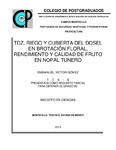| dc.description.abstract | En promedio, el rendimiento de nopal tunero (Opuntia ficus-indica), es de 5.5 t ha-1, considerándose baja productividad y repercutiendo significativamente en las ganancias de los productores. Un cladodio de nopal tunero, presenta brotes en la periferia, representando 30 % de brotación total/cladodio, quedando desaprovechados los espacios laterales. Emplear bioestimulante de la brotación en conjunto con cubiertas plásticas y riego, fue el objetivo de esta investigación y es una alternativa para incrementar brotación floral. Se usaron plantas de nopal tunero ‘Roja purpura’ de 4 años de edad, con distancia de plantación de 3x4 m. Se tuvieron dos factores: 1) Dosis de TDZ: 0 ppm, 400 ppm, 800 ppm. 2) Cubierta plástica conjunta con riego: sin cubierta y sin riego, sin cubierta y con riego, con riego y sin cubierta, con riego y con cubierta; en un arreglo factorial 3x4 con 12 tratamientos y tres repeticiones en parcelas divididas. La unidad experimental estuvo conformada por un grupo de cuatro cladodios. 44 días después de la aplicación de TDZ, el tratamiento con 800 ppm de TDZ obtuvo el mayor porcentaje brotación floral con 53.9 %, seguido de cubierta con riego con 400 ppm de TDZ con 46.8 %, superando significativamente el 12.7 % del testigo. 15 días después de la aplicación de TDZ, el tratamiento cubierto con riego con 400 ppm, presento un porcentaje de brotación floral del 99.4 %, sin embargo, este y las demás plantas que tuvieron cubierta plástica, comenzaron a revertir las yemas florales a vegetativas después de 22 días de la aplicación de TDZ, este fenómeno y la aparición de nuevos brotes vegetativos o florales se detuvo a los 44 días después de aplicar TDZ, se sugiere que la cubierta plástica, elevo y mantuvo la temperatura para estimular brotación vegetativa y ocasionar reversión floral, esto ocasiono que 6 tratamientos tuvieran frutos, por lo que rendimiento y las variables de calidad se estimaron sin poder ser analizadas estadísticamente. En un futuro experimento se recomienda retirar la cubierta plástica después de 15 de la aparición de brotes. _______________ TDZ, IRRIGATION AND COVER OF THE DOSE IN FLORAL BREEDING, PERFORMANCE AND QUALITY OF FRUIT IN NOPAL TUNERO. ABSTRACT: On average, the yield of prickly pear cactus (Opuntia ficus-indica) is 5.5 t ha-1, considering low productivity and having a significant impact on producers' profits. A cladode de pear cactus, has outbreaks in the periphery, representing 30% of total budding / cladode, the lateral spaces of the penca being wasted. Using biostimulant sprouting together with plastic covers and irrigation is the objective of this research and an alternative to increase floral sprouting. Prickly pear cactus plants ‘Red purpura’ 4 years old, with a planting distance of 3x4 m. There were two factors: 1) Dose of TDZ: 0 ppm, 400 ppm, 800 ppm. 2) Joint plastic cover with irrigation: without cover and without irrigation, without cover and with irrigation, with irrigation and without cover, with irrigation and with cover; in a 3x4 factorial arrangement with 12 treatments and three repetitions in divided plots. The experimental unit was made up of a group of four cladodes. 44 days after the application of TDZ, treatment with 800 ppm of TDZ obtained the highest floral budding percentage with 53.9%, followed by irrigation cover with 400 ppm of TDZ with 46.8%, significantly exceeding 12.7% of the control. 15 days after the application of TDZ, the treatment covered with irrigation with 400 ppm, presented a percentage of floral budding of 99.4%, however, this and the other plants that had plastic cover, began to reverse the flower buds to vegetative after After 22 days of the application of TDZ, this phenomenon and the appearance of new vegetative or floral shoots stopped at 44 days after applying TDZ, it is suggested that the plastic cover raised and maintained the temperature to stimulate vegetative sprouting and cause reversion floral, this caused that 6 treatments had fruits, so that yield and quality variables were estimated without being able to be statistically analyzed. In a future experiment it is recommended to remove the plastic cover after 15 of the appearance of shoots. | es_MX |


